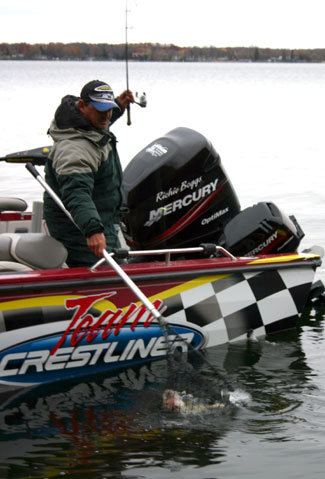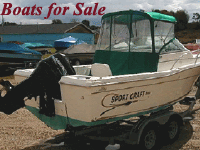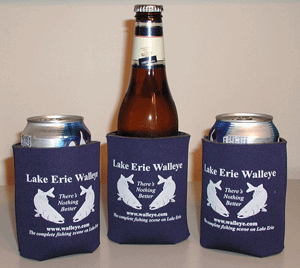| |
With the onset of the fall season times will be a
changin'
 and
some of it will definitely be for the better. While the late summer
period can be a little tough (Ok, maybe a lot of tough), what
follows can provide some of the hottest action of the entire year. and
some of it will definitely be for the better. While the late summer
period can be a little tough (Ok, maybe a lot of tough), what
follows can provide some of the hottest action of the entire year.
The changes include an improved attitude in walleyes that have
been previously been playing hard to get. Now it the time to get
busy and chow down as much food as possible wherever it is, and put
on some extra fat to help get through the tougher conditions of
winter. It’s also a time to start developing eggs which requires
plenty of nourishment. What it all adds up to is a very favorable
situation for anglers in the know.
Some of the first changes occur early in the fall period and
include a renewed interest in shallow areas like rocky bars and
reefs as well as weedy flats. The shallows play an important role
in the food chain by providing a relatively safe environment for
immature baitfish, where they can live and grow until they reach an
edible size. Bait fish that have been hiding out in heavy weed
growth can become exposed and vulnerable as some of thegreenery
starts to lay down and die.
By late summer weed flats typically begin to thin out, reducing
the amount of available cover and creating a new feeding opportunity
for hungry ‘eyes.
With all of that bait reaching a desirable size it won’t take
long for ol’ marble eyes to show up. Being the opportunists that
walleyes are, they’ll take advantage of a good situation and scads
of fresh meat that is readily accessible is a very good situation.
It also creates a terrific opportunity for anglers who know the ins
and outs of cashing in on a peak situation.
How you approach the situation will depend on a number of factors
including the type of structure you happen to be looking for, and
the attitude of the fish.
For example; If you’re faced with a rocky bar or reef using a
crankbait like #7 or # 9 Shad Rap ( either trolled or cast ) may be
the ticket. Trolling is an efficient way to cover a lot of water
but it may not be the most effective method for the given
conditions, especially if you’ve found a smaller specific area that
is holding most of the biters. In that case you may opt for
positioning the boat with a bow mount electric trolling motor like a
Minn Kota Maxxum, or dropping the hook and anchoring while casting
to the most productive spot. In either case it’s important to get
your bait running close to the bottom and even occasionally banging
into it.
If you’re working the edge or right into the middle of a weed
flat, a jig or live bait rig may be the way to go. However that
doesn’t mean you can rule crankbaits out, in fact running a Shad Rap
along the edge may be the hottest thing going.
Starting with the crankbait may be your best bet for covering
some ground and locating a few active fish. The key will be running
your bait as close to the cover as possible without constantly
fouling the it with weeds. A bait that is fouled won’t reach the
appropriate depth or achieve the right action, and will most likely
be rejected. By watching your rod tip you can see if your bait is
running clean by the watching the steady vibration. No vibration
indicates a problem that needs to be checked out and is simply part
of the program when working the weeds. To help get the vibration to
the tip try using a lower stretch line like Fireline. A lower
stretch line absorbs less of the twitch, twitch, twitch vibration of
a properly running crankbait making it easier to see.
Another key to tip watching is using a rod with the right action,
like a seven foot medium light action rod. A longer rod with a
light tip helps to accentuate a cranbait’s action keeping you on top
of what’s going on at the business end.
Once you’ve found a few fish or two with the crankbait it may pay
to go back over the area and strain it with a jig like a Northland
Tackle Eye-Ball tipped with a fathead or shiner. Quite often active
walleyes will bunch up in tight little areas and straining a spot
will increase your odds of putting together a good catch by keeping
your bait in a productive area longer.
To get back on a spot you can drop a marker if you have to, but
markers do draw crowds. A G.P.S. like Humminbird's 937C can be
accurate to within three meters of a spot and may eliminate the need
to to drop an “ I’m catching fish over here !” sign.
Early in the fall good rigging options include using crawlers or
even leeches if you can find them, or minnows like fatheads and
chubs. A Redtail Chub is without a doubt your best bet for fall
walleyes but they can be a little hard to find, and expensive.
Professional Anlger and full time guide Richie Boggs of Nisswa,
Minnesota spends litterally thousands of dollars a year on redtails
but feels there are worth the added expense; " Walleyes have a hard
time resisting a redtail chub and are a real confidence bait for
me. If I'm on active fish I know they'll take a lively chub
that's swimming and thrashing around."
Early fall is an angler’s first opportunity for cashing in on
some of the best the late season has to offer. The problem is the
fact that there’s only so much time and you better act now if you’re
going to get your share. See you on the water. |






 and
some of it will definitely be for the better. While the late summer
period can be a little tough (Ok, maybe a lot of tough), what
follows can provide some of the hottest action of the entire year.
and
some of it will definitely be for the better. While the late summer
period can be a little tough (Ok, maybe a lot of tough), what
follows can provide some of the hottest action of the entire year.